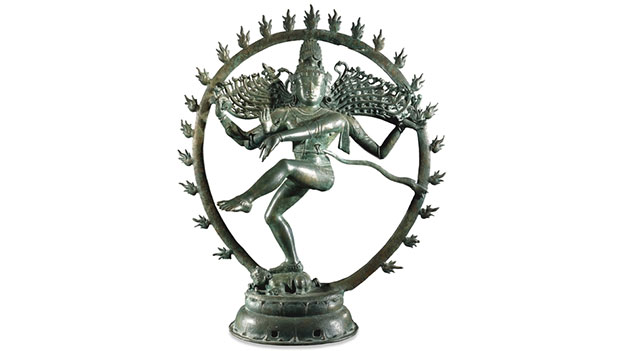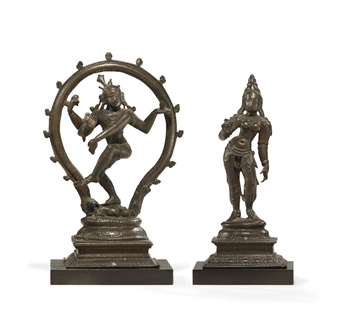It would be hard to say that Western ballet reflects to any great degree the spirit of any single nation- its origins are international. But classical Indian dance is entirely, aggressively, Indian. So also is dance sculpture, the greatest examples of which are the bronze Shiva Nataraja figures- the “dancing Shivas”- of the late Pallava and Chola eras. Shiva, the god of the myth of creation, and his symbols are fused into images of marvelous virility- immediate, animated, commanding-while in the same sculpture the changelessness of an ideal god creating and restoring the universe is apparent, above all in the treatment of the features.

—Bronze figure of Nataraja
From Tamil Nadu, southern India
Chola dynasty, around AD 1100
Dancing Shiva in a ring of fire
The Hindu god Shiva appears as the lord of the dance, Nataraja, in a ring of fire. His long ascetic’s hair flies out on either side of his head as he performs his dance. Nestling within his hair is a small figure. This is the goddess Ganga, the personification of the holy River Ganges, who, legend tells, fell to earth through Shiva’s hair. Also visible in his hair are the crescent moon and the intoxicating datura flower; both are closely associated with his wild nature. Beneath his foot he tramples upon the dwarf of ignorance, Apasmara.—click image for source…
That strange, spare, yet sensuous South Indian face, to be seen in any village of the area today, was taken by the Choa sculptors and transformed into that of a god. The human-ness is there, but deified:the seer in the guise of supple youth. It is impossible not to feel the “presence” of the deity, of Shiva, brooding in bronze.Viewed as a complete sculptural concept, the Shiva Nataraja is conceivable the supreme achievement of Indian plastic art.

—Christies:
Two small bronze figures of Shiva Nataraja and Parvati
SOUTH INDIA, CHOLA PERIOD, 13TH/14TH CENTURY
click image for source…
In addition to these bronzes there are examples in stone. The best known are at Chidambaram- legendary southern home of Shiva-where the positions of Bharata Natyam dance are sculptured on the gateways and form a frieze that encircles a courtyard about sixty yards square. Although these figures are good sculpture compaed to others elsewhere, they are said to look rather like an encyclopedia in bas-relief.

Rajasthan is a large and arid state in the Northwest with its own variety of folk dances. The bulky jewelry here is more than mere adornment for the occasion; it is tangible evidence of the family’s wealth, representing not only the dowry but whatever they have been able to add to it since…click image for source…





 COMMENTS
COMMENTS